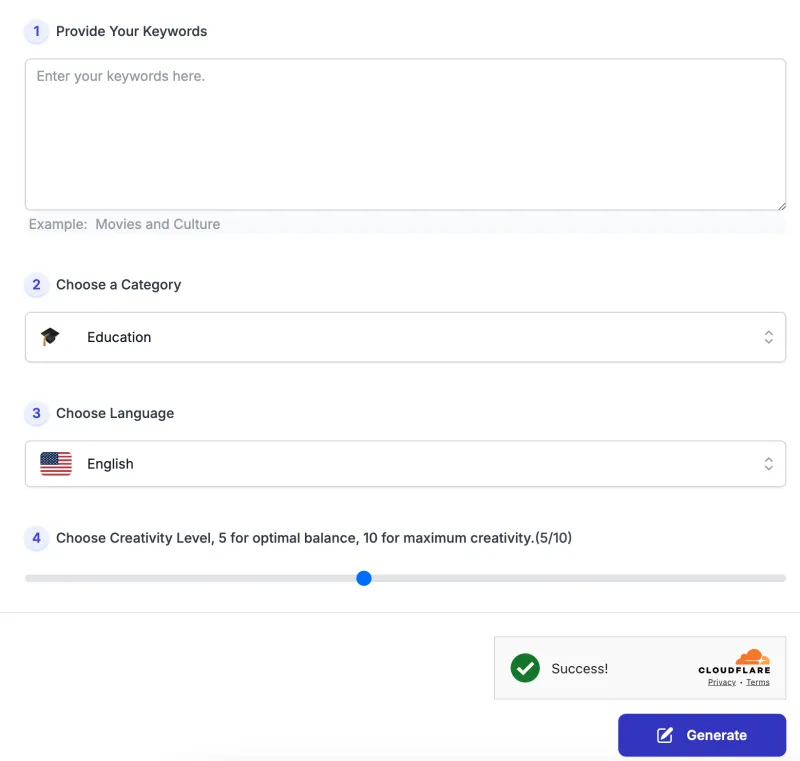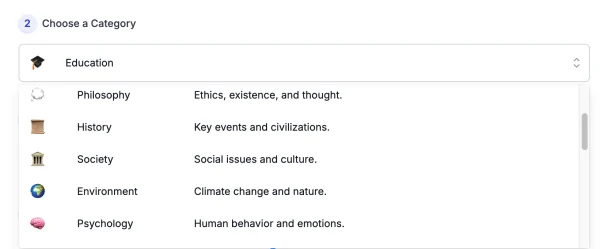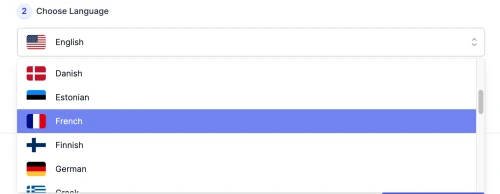Free AI Tools. No Sign-Up Required. Full Access.
AI Random Topic Generator
AI Random Topic Generator - Instantly Create Unique Discussion Topics.Inspire writing, debates, and discussions effortlessly.
Combine the current tool with these other tools to work more efficiently.
Discover other tools with functions and purposes similar to the one you are currently viewing.
Discover the tools most favored and highly-rated by users on our website.
Explore more AI tools in these related categories
AI tools that automatically create text content for your images, audio, or video from user prompts.
AI tools that generate, brainstorm, or enhance creative concepts, ideas, and inspiration.
Empower education with AI-driven tools for teaching and learning excellence.
This page offers a complete guide to the AI Random Topic Generator, designed to help users unlock its full potential. Whether you’re a writer seeking inspiration, a teacher looking for engaging discussion prompts, or a professional brainstorming new ideas, this guide will walk you through the tool’s features, benefits, and best practices. From generating unique topics tailored to your needs to maximizing creativity with advanced options, this resource ensures you get the most out of this powerful idea-generating tool.
What is the AI Random Topic Generator?
The AI Random Topic Generator is an advanced tool leveraging natural language processing (NLP) and machine learning algorithms to generate diverse, creative, and relevant topics based on user input. By analyzing keywords or selected categories, the tool dynamically produces a variety of discussion points, writing prompts, or brainstorming ideas. This tool is designed to cater to a wide range of needs, from content creators and educators to debaters and students, offering customized output that aligns with the user’s specific goals and preferences.
Why Use This Tool?
The AI Random Topic Generator provides several key benefits for users seeking creative inspiration or topic ideas:
- Overcoming Creative Block: For writers, content creators, and educators, thinking of new and engaging topics can be a challenge. This tool quickly generates fresh ideas to jumpstart the creative process.
- Customizable and Flexible: The ability to refine results by inputting specific keywords or selecting from various categories (e.g., technology, education, entertainment) ensures users receive tailored results, enhancing relevance and usability.
- Time-Saving: Instead of spending time brainstorming ideas manually, users can instantly generate multiple relevant topics with just a few clicks. This accelerates workflows, especially when tight deadlines are involved.
- Versatility Across Fields: Whether you’re preparing for a debate, generating essay topics, or looking for social media content ideas, the tool adapts to a variety of contexts, offering appropriate and targeted suggestions.
- Enhances Productivity: By automating the ideation process, the tool allows professionals to focus on more critical tasks, such as content development and strategy execution, improving overall efficiency.
This tool serves as an efficient and reliable solution for those in need of continuous inspiration or structured ideation in their professional and creative endeavors.
How to Use the Random Topics Generator: Step-by-Step Guide

Step 1. Provide Your Keywords
- In the text box labeled “Provide Your Keywords”, enter the keywords or phrases that describe the kind of topics you’re looking for. For example, you might input “Movies and Culture” if you are interested in generating topics related to those fields.
- This helps the tool focus on the specific area you want your topics to be centered around.
Step 2. Choose a Category

- Under “Choose a Category”, click the dropdown menu to select the appropriate category for the topics you want to generate. Categories can range from education and technology to entertainment or health.
- For example, choosing Education would give you topics focused on the educational field.
Step 3. Choose a Language

- In the “Choose Language” section, select the language in which you want the topics to be generated. You can choose from multiple languages based on your preference.
- The default setting is English, but you can switch to other 26 available languages depending on your needs.
Step 4. Choose Creativity Level
Adjust the creativity level by moving the slider in the “Choose Creativity Level” section. A setting of 5 offers a balanced approach, ensuring relevant and well-structured topics. Moving the slider towards 10 increases creativity, offering more diverse and unconventional topics.
Set the slider according to how open or focused you want the generated topics to be.
Step 5. Generate Your Topics
- Once you’ve entered your keywords, selected a category, chosen the language, and adjusted the creativity level, click the Generate button at the bottom of the screen.
- The tool will process your inputs and generate a list of topics that match your criteria.
Review and Use Topics
- After clicking Generate, the tool will present a list of generated topics based on your settings. You can copy, save, or refine these topics as needed for writing, discussion, or brainstorming.
By following these steps, you can efficiently generate a wide variety of topics tailored to your specific needs and preferences.
Tips and Best Practices
To get the most out of the AI Random Topic Generator, it’s important to optimize your inputs and approach. Here are some tips and best practices for using the tool effectively:
1. Selecting Effective Keywords
- Be Specific: The more specific your keywords, the more focused and relevant the generated topics will be. For instance, instead of using a general term like “technology,” try something more detailed like “AI in healthcare” or “Blockchain applications in finance.”
- Use Multiple Keywords: Combining different keywords can help refine the generated topics. For example, using “Education” with “Online Learning” can produce more targeted topics than just using “Education” alone.
- Experiment with Broader and Narrower Terms: If you’re not sure what type of topics you want, start with broader keywords like “Environment” or “History.” If you’re looking for very specific topics, use more detailed keywords such as “Climate Change Policies” or “World War II Economic Effects.”
2. Choosing the Right Category for the Desired Output
- Match the Category to Your Goal: Each category produces topics based on a specific area of focus. For example, if you’re writing a research paper on technological advances, selecting the Technology category will yield the most relevant results. If you need essay prompts for education, choose the Education category.
- Consider the Audience: If you’re generating topics for a professional audience, categories like Business, Politics, or Health might be more appropriate. For more casual or creative outputs, consider Entertainment, Lifestyle, or Art & Literature.
- Combine Categories for Inspiration: If you’re unsure of what you’re looking for, try using broader keywords and select different categories to see which one gives the best inspiration. This can help you explore new angles on a subject or find fresh perspectives.
3. How to Use Generated Topics for Writing, Discussions, or Brainstorming
- Writing: Use the generated topics as prompts for essays, blog posts, or research papers. The tool’s ability to create diverse and creative topics can help you approach your writing from unique perspectives. You can also combine multiple topics to form a cohesive piece with different viewpoints.
- Discussions: For classroom or group discussions, the generated topics can serve as a foundation for debate, group brainstorming sessions, or educational talks. Make sure to adjust the creativity level based on whether you want the topics to be more structured or open-ended for debate.
- Brainstorming: If you’re in the early stages of idea generation, use the tool to create a wide variety of topics. Don’t limit yourself to just one; generate several sets of topics and mix and match ideas to create new concepts or directions for projects, presentations, or speeches.
By following these tips, you can maximize the tool’s output and generate relevant, unique, and engaging topics tailored to your specific needs, whether for writing, discussion, or creative brainstorming sessions.
Common Issues and Solutions
Although the AI Random Topic Generator is designed to produce a wide variety of creative and relevant topics, you may encounter some issues when generating topics. Here are some common problems and solutions to help you get the best results:
1. Getting Irrelevant Topics: How to Refine Input
Sometimes the generated topics may not be closely related to your input, producing irrelevant or off-topic results.
Solution:
- Refine Keywords: If the topics seem off-target, consider refining your input keywords. Be more specific with the terms you enter. For example, if “Technology” yields broad results, narrow it down by adding “Artificial Intelligence in Healthcare” or “Blockchain Security.”
- Use Multiple Keywords: Combining multiple keywords can guide the AI toward more accurate topics. For example, instead of just using “Movies,” try combining it with “Cultural Impact” or “Historical Representation in Films.”
- Rephrase Input: Rewriting or rephrasing your keywords can also help fine-tune the topics. If “Environmental Issues” doesn’t give you relevant topics, try “Climate Change Solutions” or “Sustainable Energy Practices.”
2. Too Few or Too Many Topics: Adjusting Settings
You may find that the tool generates too many irrelevant topics or too few usable ideas.
Solution:
- Adjust Creativity Level: The creativity slider allows you to control how creative or structured the generated topics are. If you’re getting too many abstract or irrelevant topics, lower the creativity level to make them more focused and practical. If you want more varied or experimental ideas, increase the creativity level.
- Experiment with Broader/Narrower Keywords: If you’re getting too few topics, try using broader keywords to generate more ideas. On the other hand, if you’re overwhelmed with too many, more specific keywords can help reduce the number of generated topics.
- Limit or Expand Category Selection: Sometimes too many options come from selecting categories that are too broad. Choose more focused categories to limit results, or expand your selection if you need a wider range of ideas.
3. Topic Redundancy: Use Advanced Options (Filters, Categories)
You may notice that some of the generated topics are repetitive or too similar to each other.
Solution:
- Use Different Categories: If the topics feel redundant, consider switching to different or additional categories. For example, if you’re generating topics from the Business category and they seem repetitive, try adding Technology or Social Issues to introduce new angles.
- Refine Keywords Further: Use more precise or varied keywords to prevent similar topics from being generated. For instance, instead of using “Education,” specify “Remote Learning,” “Education Policy,” or “Innovative Teaching Methods.”
- Vary Input and Refresh: After generating a set of topics, refresh the input with different keywords or combine new terms to diversify the output. Try different keyword combinations or change your approach to the topic to see if it gives you new and varied results.
By following these solutions, you can ensure that the random topic generator tool generates the most relevant, creative, and unique topics, tailored to your specific needs and preferences. If problems persist, tweaking the input or adjusting the settings can greatly improve the output.
FAQs
What can I use the AI Random Topic Generator for?
The tool is versatile and can be used for generating topics for writing, discussions, brainstorming, debates, and content creation. It’s suitable for professionals, educators, students, and creatives who need inspiration or starting points for various projects.
How many topics can I generate at once?
You can generate as many topics as you need.
How do I make the generated topics more specific to my needs?
To get more focused topics, ensure your input keywords are detailed and precise. You can also select a specific category (like Education, Technology, or Entertainment) and adjust the creativity level for more or less structured output.
Can I generate topics in languages other than English?
Yes! The tool offers 27 multi-language support. You can choose the language you prefer from the Language Selection option before generating topics.
What should I do if the topics generated aren’t relevant?
If the generated topics seem irrelevant, refine your input by using more specific keywords. You can also experiment with different categories or adjust the creativity level to get more relevant suggestions.
Can I save and share the topics I generate?
Yes! You can save generated topics for later use or share them directly via email, social media, or other platforms.
Is there a limit to how often I can use the tool?
No, you can use the tool as many times as you like. There’s no limit to how often you can generate topics, so feel free to experiment and generate multiple sets of ideas.
What’s the difference between different creativity levels?
The creativity level controls how structured or creative the topics are. A lower level (e.g., 3-5) produces more focused and practical topics, while a higher level (e.g., 7-10) generates more diverse and unconventional ideas, perfect for brainstorming or creative exploration.
What do I do if the topics feel repetitive?
If the topics seem too similar, try changing your input keywords, selecting different categories, or adjusting the creativity level. You can also use the tool’s advanced settings to filter and customize the output further.
Can I use this tool for timed debates or speech practice?
Yes! The Timed Topic Creation feature allows you to set intervals (e.g., every 1, 5, or 10 minutes) to generate a new topic for timed debates, speeches, or impromptu practice sessions.